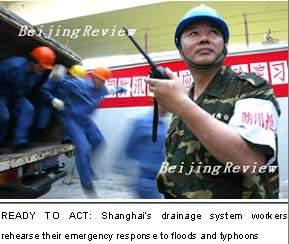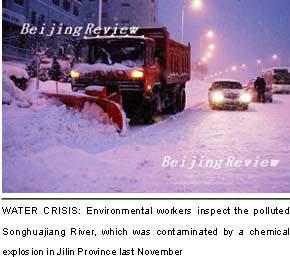Coping With Disaster
FENG JIANHUA

China has just put in place its first basic system to respond to national emergencies
“We officials talk about all kinds of emergencies across the city and discuss what should be done to tackle them while we are having lunch at the canteen every day,” said Wang Qishan, Beijing Mayor.
Wang was appointed head of Chinas capital city three years ago, when the country was fighting the spreading severe acute respiratory syndrome (SARS) epidemic in 2003 spring. His efforts on behalf of controlling the disease gained him worldwide notice and the title of a “firefighter and problem solver.”
Wang, who has some experience in emergency management, said he dared not take even the smallest incident lightly. Beijing has seen a number of emergencies in recent years, and even heavy snow, rain or fog could cause traffic paralysis that requires intervention. How Beijing deals with incidents draws widespread attention, both at home and abroad, so any public emergency, in Wangs eyes, is like a nightmare.
Other top officials at all levels of government share that feeling. Faced with crises, they are undergoing a transformation from reacting passively to taking the initiative in preventing and resolving such incidents. This stems from an improving system of official accountability and the pressure of public opinion.

Last December, there was relentless heavy snowfall in the coastal city of Weihai, Shandong Province, which could have posed a threat to the lives and property of local residents if not handled in a timely manner. Under severe circumstances, the local government established an emergency response squad and activated an emergency operation plan. As a result, rescue operations were carried out in an orderly manner and the crisis was finally resolved.
“The lesson we drew from this crisis is that gathering information immediately is very important in dealing with emergencies,” a Weihai official said.
But its also acknowledged that some local governments are not prepared to handle contingencies and some even turn a blind eye to them. When it comes to cases in which official corruption is involved, incidents are usually covered up. For instance, there have been major mining accidents in China, but the first move by the local government involved is to block the news, then secretly try to resolve problems arising in the aftermath. As a result, the same type of accident happens again and again, and the situation grows worse.
Communi-cation and coordination are also important when different regions are involved in an emergency. The water pollution incident in the Songhuajiang River in northeast China last November is a case in point. A toxic spill leaked into the river after an explosion in an upstream benzene plant in Jilin Province. Unfortunately, the local government didnt publicize the accident immediately and this led to polluted water running downward to Heilongjiang Province, causing a major crisis.
Guidelines on emergencies
Such irresponsible actions will no longer be tolerated under the national plan for emergency response that was announced by the State Council, Chinas cabinet, on January 8. The plan is a guide to prevent and deal with various incidents in China, including those involving more than one province.

All provinces, autonomous regions and municipalities have also drawn up corresponding plans. Therefore, a trans-regional crisis can be handled more effectively.
Incidents are divided into four categories: natural disasters, accidents, health contingencies and public safety incidents. They are also ranked into four classes, I to IV, from the most to least serious, according to the incidents characteristics, severity of damage and difficulty in handling. The classes are color-coded red, orange, yellow and blue.
The plan stipulates that local governments should briefly publicize the news immediately after an emergency takes place. After that, verified information, the governments countermeasures and precautions should be made known to the public. Major emergencies or incidents must be reported to the State Council within four hours.
According to the plan, basic needs of incident-affected people, especially those suffer natural disasters, must be met. They must have food, water, clothing, shelter and medical services. Thus, medical departments should form emergency medical teams in order to go to the scene of an accident to assist victims. A smoothly functioning transport system for supplies must also be guaranteed.
A liability system is also included in the plan. Those who fail to report an incident in a timely manner, or who lie about it or try to cover it up, will be penalized. Those who fail to carry out their duties or are involved in malpractice will face administrative sanctions, while those who commit a crime will be subject to criminal penalties.
International experience shows that a society faces a high risk of instability when its annual per-capita gross domestic product is between $1,000 and $3,000. China is right in the middle of the “high risk” period when various public safety accidents and emergencies easily and frequently happen. Due to its geological conditions, China is one of the countries that suffer the most serious natural disasters, and, with the growing population movement, health contingencies have begun to emerge as a big threat. Half of the 30 infectious diseases that have been discovered around the world recently have been reported in China. Whats worse, Chinese has long paid little attention to disasters, and its people lack both awareness and the ability to protect themselves.

Learning a lesson
China paid a high price during the SARS epidemic in 2003, but it also taught the countrys top leaders a lesson about the importance of setting up an emergency response system. Since then, the expression “emergency response” has been included at the top of the Central Governments agenda and become a catchword among the public.
Chinas State Council therefore established a special working team to draft the emergency response plan. After two years of discussion and consultation with experts, as well as repeated modifications, the national plan for emergency response finally came out at the start of this year.
But it cannot accomplish everything. There are bound to be unexpected incidents and disasters for which planning has been inadequate. Thus, officials emphasize the release of the emergency response plan is just a beginning.
Of course, a plan is good for nothing if it cannot be put into practice. Therefore, equal importance should be attached to implementing the plan in practice and improving it through experience.
Furthermore, during an emergency, civil rights will be limited or restricted if necessary, and citizens property might be requisitioned. In such cases, avoiding an abuse of power and corruption is beyond the reach of the emergency response plan and needs to be dealt with through related laws.
At present, a state of emergency bill has been listed on the legislation schedule of the National Peoples Congress, Chinas top legislature. From the aspect of law and administrative management, however, it can only be used on the premise that the public interest is endangered, said Yu An, professor at the School of Public Policy and Management of Tsinghua University who is in charge of the research project for state of emergency legislation entrusted by the Office of Legislative Affairs under the State Council.
How China Developed Its Emergency Response Mechanism
At the beginning of 2001, Shanghai started drafting the citys disaster and emergency response plan. Two years later, the plan was completed, becoming Chinas earliest document of its kind at the provincial level.
May 2002, Nanning, the capital city of Guangxi Zhuang Autonomous Region, activated its emergency system. This is Chinas first city emergency management system.
May 2003, the Regulations on Public Health Contingencies were released.
July 2003, the Chinese Government proposed establishing a public emergency response system, and the General Office of the State Council immediately formed an emergency response working team.
September 2003, the emergency response plan on Beijings SARS prevention and control was released.
May 2004, the General Office of the State Council issued a document ordering governments at provincial and municipal levels to work out their own general emergency countermeasures and to report them to the general office for recording.
January 2005, Premier Wen Jiabao presided over a meeting to discuss the national plan on emergency response, 25 special emergency plans and 80 departmental emergency plans.
July 22-23, 2005, the State Council held a national conference on emergency management, making the work a routine of the government.
The State Council issued the national plan on emergency response on January 8, 2006, and all provinces, autonomous regions and municipalities have developed corresponding plans. Therefore, an elementary emergency response framework has been set up in China.

